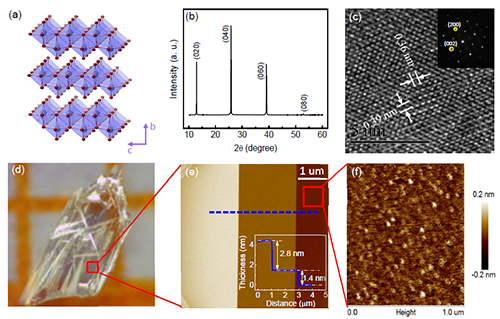Synaptic transistor implemented using quasi-2D molybdenum oxide
Date:16-05-2017 Print
In recent years, there have been increasing interests in building artificial synaptic devices to emulate the computation performed by biological synapses. The biological synapses are functional links between neurons, through which information is transmitted in the neuron network. The information can be stored and processed simultaneously in the same synapse through tuning synaptic weight, which is defined as the strength of the correlation between two neighboring neurons, and the operation is collective and adaptive. Although silicon-based complementary metal-oxide-semiconductor (CMOS) circuits have been developed to emulate synaptic behaviors, it is still facing significant challenges in terms of large-scale integrations and huge energy consumption.
Ionic/electronic hybrid three-terminal memristive devices, in which the channel conductance can be modulated according to the history of applied voltage and current, provide a more promising way to emulate synapses by substantial reduction in complexity and energy consumption. Two-dimensional (2D) van der Waals materials, such as 2D transition metal dichalcogenides (TMDCs), with a thickness of single or few layers of crystal unit cell have been a widespread innovation in three-terminal electronic devices. However, less attention has been paid to the 2D transition metal oxides which have more stability and technique compatibility.
Recently, Associate Prof. SHANG DASHAN and Prof. SUN Young from Institute of Physics, Chinese Academy of Sciences have implemented a nanoscale three-terminal memristive transistor based on quasi-2D α-phase molybdenum oxide (α-MoO3) to emulate biological synapse. In this device, ionic liquid is selected as gate terminal for the input of pre-synaptic spike. The ultrathin α-MoO3 single crystal is used as the channel, whose conductance can be considered as the synaptic weight. The post-synaptic current is measured between the source and drain. The ambient water molecules are originally adsorbed by the ionic liquid and then electrostatically dissociate into protons and hydroxyls. By applying an electric voltage pulse to the gate, the protons in the ionic liquid gate are injected/extracted into/from the channel, resulting in the reduction/oxidation of the α-MoO3, which modulates the channel conductance. Based on this mechanism, the essential synaptic behaviors, such as paired-pulse facilitation and transition from short-term to long-term potentiation, have been demonstrated in the three-terminal devices in a low-energy way. This work represent the first example of applying 2D α-MoO3 to artificial synapse, and will be meaningful for the fabrication of nanoscale synaptic devices with high scaling ability, low energy consumption, and high processing efficiency.
This study entitled “A synaptic transistor based on quasi-2D molybdenum oxides” was published on Advanced Materials.
The study was supported by the National Science Foundation, the Ministry of Science and Technology of China, the Chinese Academy of Sciences and grants from US.
 |
| Fig.1 Crystal structure and surface topography of α-MoO3. (Image by Institute of Physics) |
 |
| Fig.2 The structure, electrical transport, and proton injection mechanism of the quasi-2D α-MoO3-based three-terminal transistor. (Image by Institute of Physics) |
 |
| Fig.3 Simulation of the excitatory postsynaptic current (EPSC) by applying gate voltage pulse to the quasi-2D α-MoO3-based three-terminal transistor. (Image by Institute of Physics) |
 |
| Fig.4 Simulation of the pulse pair facilitation (PPF), synaptic weight potentiation/depression, and short-to-long term memory behaviors by using the reversible multilevel channel conductance switching of the quasi-2D α-MoO3-based three-terminal transistor. (Image by Institute of Physics) |
Contact:
Institute of Physics
SHANG Dashan and SUN Young
Email:shangdashan@iphy.ac.cn; youngsun@iphy.ac.cn
Key word:
memristive system; two-dimensional transitional metal oxide; synaptic transistor; synaptic plasticity
Abstract:
Quasi-two-dimensional transition metal oxide, α-phase molybdenum oxide (α-MoO3), has been used to fabricate three-terminal transistors with ionic liquid gating. The essential biological synaptic behaviors, such as excitatory post-synaptic current, depression and potentiation of synaptic weight, paired-pulse facilitation, the transition of short-term plasticity to long-term potentiation have been demonstrated in the three-terminal devices.

